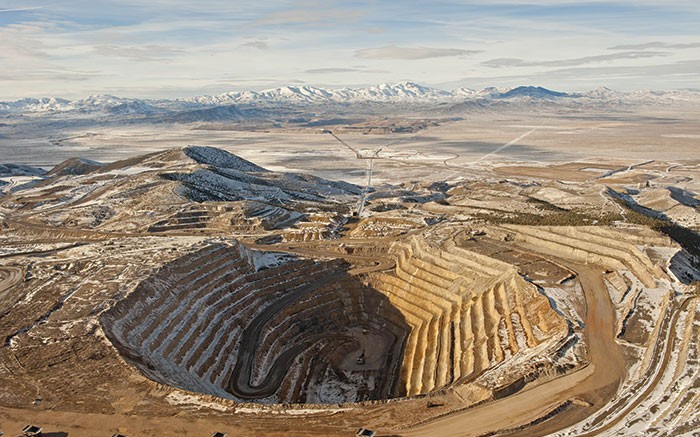Barrick Gold (TSX: ABX; NYSE: ABX) is benefitting from going back to the basics, under the direction of chair John Thornton.
“Last year was the first time in four years this company generated net-positive cash flow,” Thornton told reporters on the sidelines of a Feb. 18 breakfast event in Toronto hosted by law firm Torys LLP.
Despite the lower gold price, the company produced US$471 million in free cash flow in 2015, including US$387 million in the fourth quarter. This compares to 2014’s negative free cash flow of US$136 million, when gold prices on average were US$106 per oz. higher than in 2015.
Last year was also the first full year Barrick was under Thornton’s guidance. Since taking the top job in April 2014, the former Goldman Sachs executive has streamlined the organization and laid out a strategy to refocus on quality ounces, increase returns and cut Barrick’s heavy debt load, amounting to US$13.1 billion at the end of 2014.
“We have been too highly levered, so we had no choice but to bring down the debt,” Thornton said during the event.
In 2015, Barrick lowered its debt by US$3.1 billion — slightly ahead of its target — through asset sales, joint ventures and partnerships. As part of the transactions, Antofagasta (LSE: ANTO) paid US$1 billion in cash for half of Barrick’s Zaldivar copper mine in Chile, and Royal Gold (TSX: RGL; NASDAQ: RGLD) forked over US$610 million for a gold-silver stream from the Pueblo Viejo mine in the Dominican Republic.
While Zaldivar initially generated buzz in the market, with 21 interested companies, Thornton noted there were only a few serious buyers. “When you get down to the bitter end and someone’s got to reach in his or her pocket and give you the money, and give the money that’s attractive to us — few people are standing,” he said. “It means that in a tougher market, trying to do more difficult things, the sheer skill of the people actually doing the execution has got to be much higher.”
This year, Barrick plans to trim its US$10-billion debt by at least US$2 billion, using its US$2.5-billion cash balance, free cash flow from operations and selling more assets.
Although it will focus on non-core asset sales, Barrick will keep all of its assets “on the table” to create optionality.
“We would rather not sell all or part of a core asset if we can avoid it. But we don’t always have the choices, so we keep it open,” Thornton told reporters.
More recently, the company said it would redeem up to US$750 million in notes to help lower debt.
In 2015, Barrick reported a net loss of US$2.8 billion, or US$2.44 per share. The loss included US$3.1 billion in goodwill and asset impairments, mostly related to its suspended, half-built Pascua-Lama mine on the Chile-Argentina border, and Pueblo Viejo. Adjusted earnings were US$344 million, or US30¢ per share, which is less than half the adjusted amount earned a year ago.
Full-year gold production came in at 6.12 million oz. at all-in sustaining costs (AISC) of US$831 per oz., both within expectations.
For 2016, Barrick has guided gold output of 5 million to 5.5 million oz. at between US$775 and US$825 AISC. The lower production is due to the asset sales. Expected production in 2017 should stay within the 2016 range, before dropping in 2018 to 4.6 million to 5.1 million. It expects to keep annual gold production of at least 4.5 million oz. through 2012.
AISC should improve each year, with Barrick aspiring to bring AISC down to less than US$700 per oz. by 2019.
The target is “aggressive” but “achievable,” Richard Williams, Barrick’s chief operating officer, said on a conference call. The company has already identified a couple hundred million dollars of savings at its operations, and will release details soon, Williams said.
Meanwhile, the miner has refined its strategy to grow free cash flow in any gold price environment, with a portfolio that delivers a 10–15% return on invested capital through the current metal price cycle. All new capital spending should deliver a 15% return, based on Barrick’s long-term gold price assumption of US$1,200 per oz.
“We’re building a business that will be gold-price agnostic. That is to say, our goal is to make money under any circumstances,” Thornton said. “As a practical matter, we do that by making ourselves so low cost that almost in any scenario we are going to make enough money to pay a company dividend. Then time to time, the investor will get a windfall … sometimes a small one and sometimes a large one, depending on the gold price — as long as you stay disciplined and don’t chase the price, which was done historically.”
On Feb. 22, Barrick reported the results of four studies on projects in Nevada and Peru that could increase gold production and grow free cash flow beyond 2020. Preliminary costs for the projects total US$2 billion, with construction starting in 2019 and 2020.
Barrick envisions building a US$1-billion underground mine at its Goldrush project in Nevada. Annual production for the first five years should average 440,000 oz. gold at US$665 per oz. AISC.
It also intends to invest US$640 million to extend the life at the Lagunas Norte mine in Peru by nine years. Annual production for the first five years should average 240,000 gold oz. at AISC of US$625 per oz. Other investments in Nevada include spending US$300 million to US$325 million to boost production at its Turquoise Ridge mine, and another US$153 million to expand underground mining at the Cortez Hills mine.
Barrick will use its 15% hurdle rate to assess further project spending.
Its shares in Toronto at press time traded at $17.55, up 71% from its 2015 close.


Be the first to comment on "Thornton’s Barrick looks leaner"